A review of the land mollusks of the Belgian Congo
Agaatslakken (Achatina)
In the period from 1909-1915 The American Museum of Natural History in Philadelphia had some expeditions to what was then the Belgian Congo (now Democratic Republic of Congo). These expeditions were largely conducted in two districts:
Lower Congo, from Leopoldsville (Kinshasa) and Thysville (Mbanza-Ngungu) to Banana at the estuary and in the Aruwimi-Ituri valley. Occasional investigations were also conducted in
Stanleyville (Kisangani) and northeast of the rainforest in Faradje.
Henry A. Pilsbry (Iowa City, December 7, 1862 - Lantana, Florida, October 26, 1957) investigated more than 6,000 land snails from the Belgian Congo, 4,200 of which were collected during the aforementioned expeditions.
The others came from other expeditions such as that of J. Bequart near the Semliki River, on Mt. Ruwenzori (now the Rwenzori Mountains), south of Rutshuru and in Lower Congo.
The result of the research was cast in a book: 'A review of the land mollusks of the Belgian Congo'.
From the approximately 400 species described, we only consider the Achatina species here.
Titel
Observations show that the Achatina species are mainly found in plantations and near villages. They can be found everywhere, especially after heavy rains. Outside the rainforest, in the savanna areas, large snails are much rarer. During the dry season, which can take up to four months, they burrow. The apertura (mouth) is closed with an epifragm. In this way, they can survive a period of low moisture and food. In addition, they are thus protected against grass fires. When the first rains fall, the snails become active again.
Agate snails are largely found in low-lying areas. In the mountains and plateaus in Central Africa, the number of species and the population density decrease from 1200 meters. They cannot be found above 1500 meters.
Species described
Despite the size of the former Belgian Congo, the number of species of agate snails is limited, although no expedition to the Katanga region had been carried out at the time of publication.
It is also noted that no species is found in both rainforest and savanna.
The following species are described (with the names used in the book):
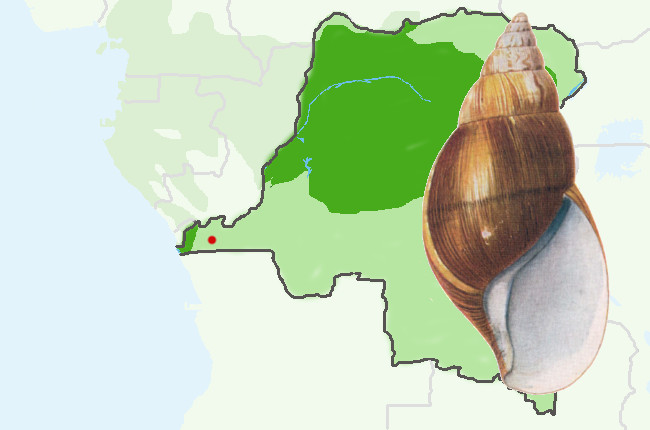
Achatina bandeirana (Morelet, 1866)
Location: Savanna from Banza Manteka (between Matadi and Lukungu) and Kunga
Maximum length: 143mm, diameter: 72mm
This species is very similar to Achatina balteata. Achatina balteata var. infrafusca described by Martens based on shells from Banana actually turns out to be Achatina bandeirana.
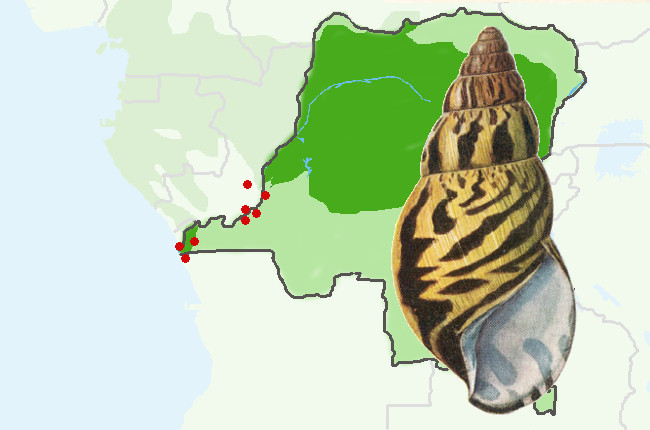
Achatina tincta (Reeve, 1842)
Location: Banana, Leopoldville (Kinshasa), Ile de l'elephant, between Stanley Pool (Pool Malebo) and Kwamouth, Malela, Moanda. San Antonio (Angola) and Brazzaville, Pays M'bagba and Fort Rousset (Congo-Brazzaville).
Maximum length: 101mm, diameter: 45mm
The drawing is very variable. The species Achatina oblitterata appears to be only a mutation of Achatina tincta. Both color forms occur together. This is a fairly common species that can be found
under dry leaves where they hide and feed on plant debris.
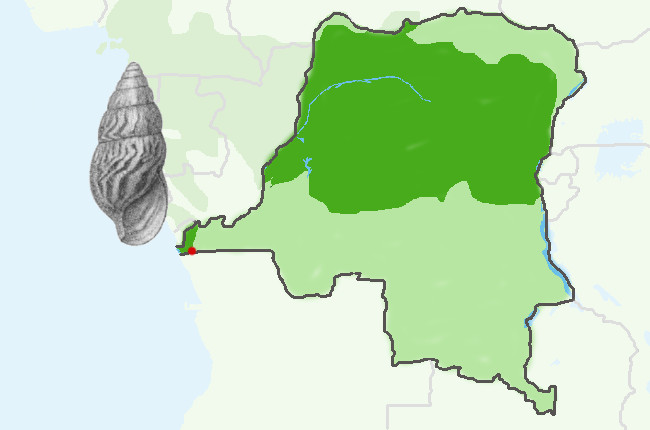
Achatina pfeiferri (Dunker, 1845)
Location: Zambi
Maximum length: 35mm, diameter: 15mm
The specimens examined differ from the type specimen and are likely a local subspecies called Achatina pfeiferri eugrapta.
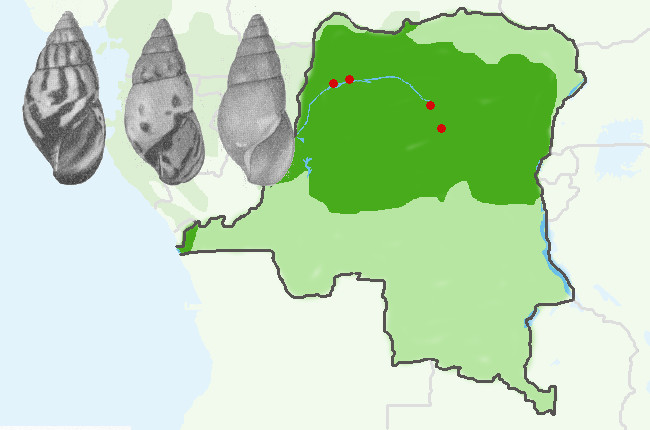
Achatina sylvatica (Putzeys, 1898)
Location: Stanleyville (Kisangani), Mobeka, Nouvelle Anvers (Makanza) along the Congo River.
Maximum length: 41mm, diameter: 20mm
This species has an evenly colored mutation called 'unicolor', but the striped specimens also have a wide variety of markings: from many stripes to just a few dots.
In Stanleyville (Kisangani), the snails were found among the grass.
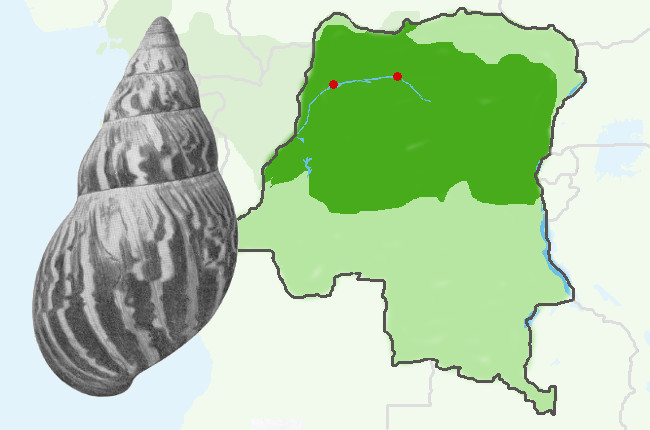
Achatina weynsi (Dautzenberg, 1899)
Location: Bumba, Nouvelle Anvers (Makanza) along the Congo River.
Maximum length: 114mm, diameter: 60mm
This species resembles Achatina tincta but is found in a distribution area far from the described habitat of this species. The habitat is adjacent to that of Achatina schweinfurthi.
The pattern on the house is often striped in different thickness. Some specimens even have an almost solid color.
A mutation 'rosaxis' has been found in which the stripes are not chestnut colored but cinnamon colored.
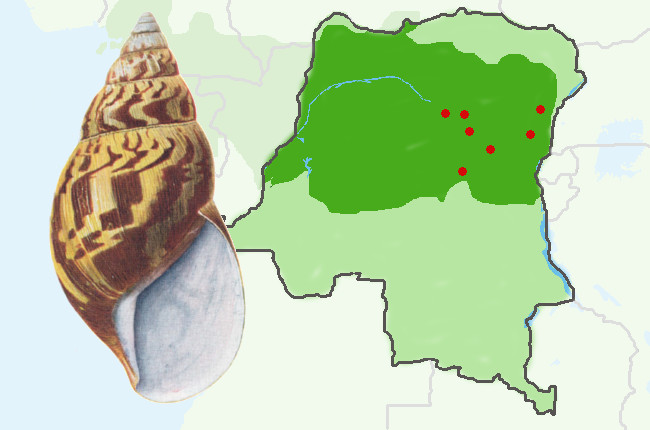
Achatina schweinfurthi (Martens, 1873)
Location: Eastern Congo: in forests on the flanks of Mt. Baginze and Mt. Ruzenzori, Andetei region, west of the Semliki river, Nsendwe, Lokandu, Piani Kapuri, Ponthierville (Ubundu), Stanley Falls (Boyoma Falls), between Mawambi and Avakubi, Niangara, Medje
Maximum length: 171mm, diameter: 83mm
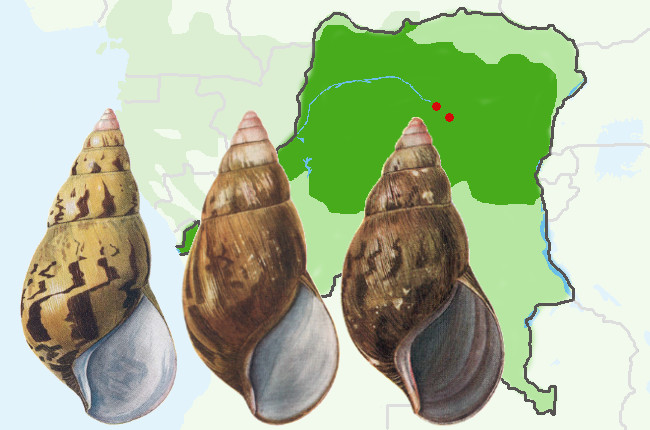
Achatina schweinfurthi rhodacme (Pilsbry, 1919)
Location: Stanleyville (Kisangani), Lubutu
Maximum length: 150mm, diameter: 72mm
This subspecies (left) was described by Pilsbry in which he also determines 2 mutations, namely rhodostemma (middle) and levior (right).
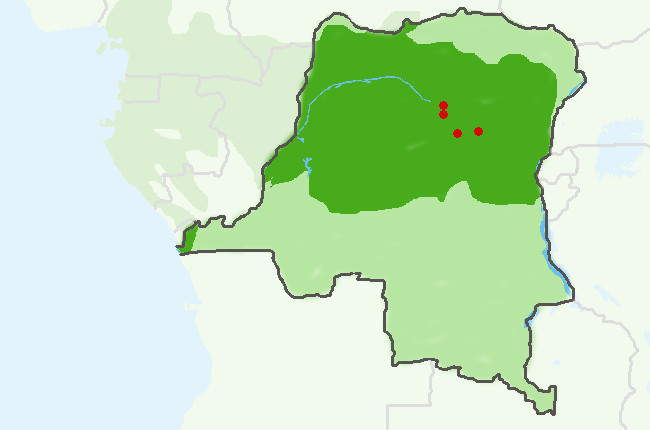
Achatina rugosa (Putzeys, 1898)
Location: In the rainforest on the right side of the Congo River in Micici, Musungu Kifuluka, Nsendwe, Lokandu, Ponthierville (Ubundu) and Stanley Falls (Boyoma Falls)
Maximum length: 106mm, diameter: 52mm
Achatina iostoma is possibly a synonym for this species.
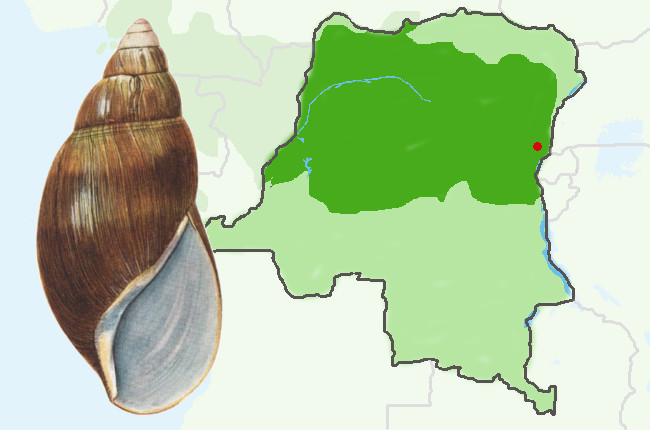
Achatina osborni (Pilsbury, 1919)
Location: In the rainforest near Masisi
Maximum length: 141mm, diameter: 66mm
Described by Pilsbury and named after Professor Henry Fairfield Osborn, President of The American Museum.










